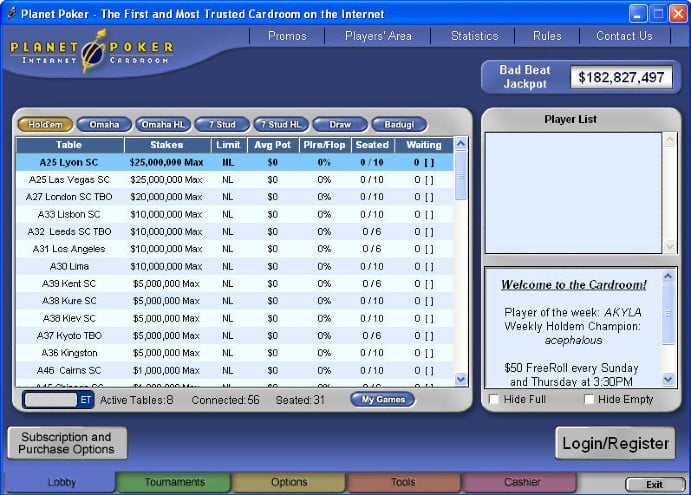The never changing lobby
The part of the poker client that generally gets the least attention
may actually be the most important.
In 1997 I was an undergraduate at Oxford, regretfully not spending
my time coding a website to rate the attractiveness of fellow students. Google was an actual search engine. Amazon made the decision to
sell more than books. That year also marked The Beginning for online
poker. The lobby of the time was a list of available tables in,
unsurprisingly, a table. This is because the standard way to list
items with some attributes is a table and tables are a foundational
UI construct. So, in summary, it was tables, displayed in tables,
using tabular technology.

Of course, this was just the first iteration, and it was over a
quarter of a century ago. Two decades after Planet Poker arrived,
Party announced that 'totally revamped' lobbies were officially a 'major focus'. That
major focus led to... tables. Under some tabs (aka table filters). Two
decades! To basically replicate a website. In some cases they probably
spent significant engineering time building the equivalent of a proprietary
browser engine to render it. This is par for the course with overhyped
announcements about trivial poker client updates - this is Kindred, probably trying to hit an investor document word count, noting
that they are 'designing features to avoid free text becoming too
emotional' by using a 'library of animated memes and emoticons'.
Exciting!
Standard or straightjacket?
It would be somewhat churlish to criticise the poker client
designers for this de facto standardisation. If you accept the
current online poker orthodoxy, there is little wiggle room here,
especially if the primary (unwritten) requirements to 'allow
customers to pick from a range of different poker table games'. Some
people will point to the the imposed complexity of regulatory rules,
but it is really about two decades of technological development
meeting the seemingly immovable object of the only customer cohort
you really care about becoming attuned to a specific UI workflow. I
doubt that any members of a poker room team have woken up one Monday
morning, thrown off their rake table covered duvet, and exclaimed, Jerry Maguire style, 'Today I am going to propose
a radical departure from the accepted norms for the lobby as it will
be an exciting all-in bet on my job!'
The problem with that approach is that it significantly reduces the
competitive terrain. Now you have to overtake whichever company is
currently mining the very very very grey markets based on your
unique ability to customise the colour of the virtual table felt. Emoticons
allows Kindred to add a few 'better add something about poker' lines
to their end of year report, and implementing and blogging about similar
things evidently keeps some people at Entain partly employed, but the
question 'how can this possibly turn us into the leader in the poker
category?' is the elephant in the room.
Routing and status
The mistake here would be to think that the problem/opportunity is a
UI issue, resolved with a swipe of an artistic brush. It is actually
a business model issue. The lobby is fundamentally a routing
product with a secondary role of status. It is routing in that it helps
players move to different product areas with more or less efficiency.
Sometimes this aspect can be considered agnostic from an operator perspective
(although the commercial importance of cross selling means that this
is less true now than a decade ago), but often it is an explicit choice.
Status, in the current setup, is a minor concern - often as insignificant
as a number representing your bankroll. If you stop presenting customers
with a slightly curated list of revenue-generating options, the balance
shifts. Now, you can optimize for pathways — ideally ones that adapt dynamically.
Status becomes much more important, reflecting a more complex customer
journey. In this model, tables become a hindrance, so you can eliminate
pointless scrolling.
As unpoker is not a poker product
we have a bit of an advantage here - we don't need to follow some
norms that were seemingly hard coded decades ago. Like a traditional
poker site we have different games, but in most instances they would
not exist in a structure that would benefit from a tabular
presentation. The lobbies of unpoker implementations will ultimately more closely reflect the
thematic structure rather than the product one, in line with a horizontal approach. As these lobbies are driven more by code than graphics, there
are new opportunities for optimization—similar to how Netflix personalizes artwork. The core principle is simple. To better guide players, remove or
hide unnecessary complexity. Make it easier for customers to find
what they need.
No surprises
Many software products are shaped by a dominant UI model that lasts
for years. Sometimes, there are big leaps—like moving from
Yahoo-style listings to Google’s search box. Even email clients,
which have clear boundaries, have evolved over time. Lobbies should
have been redesigned into something more compelling and effective,
not just the product of a spreadsheet-brained designer’s
imagination.
Philip Atkinson, CEO, updated May 2025